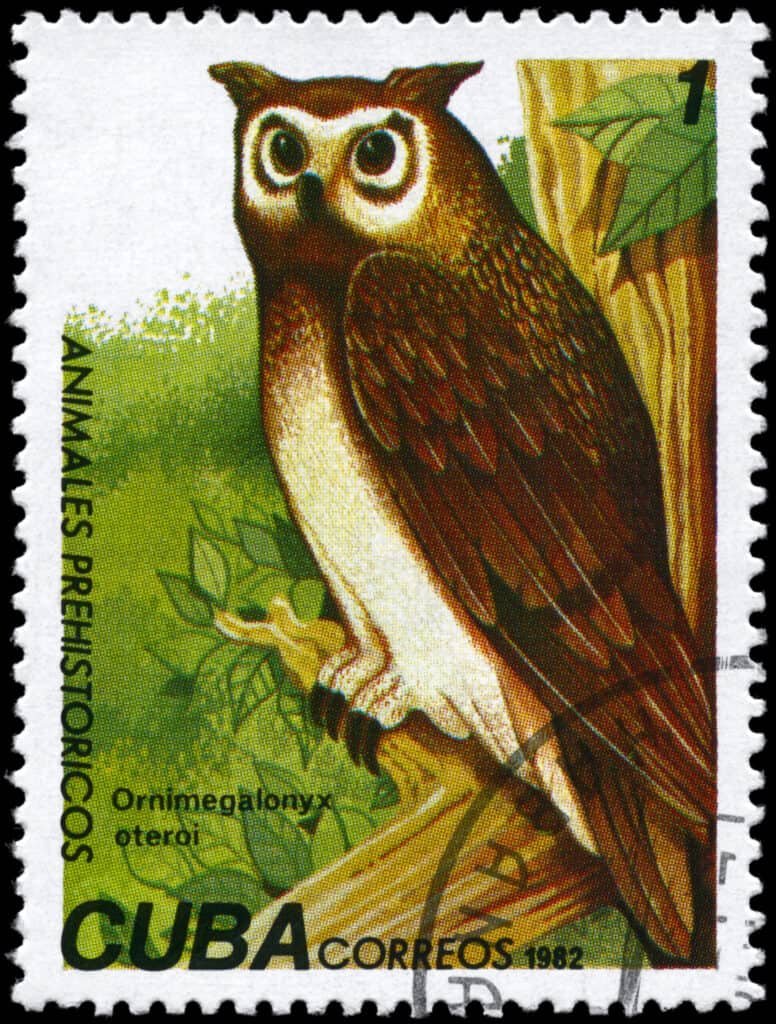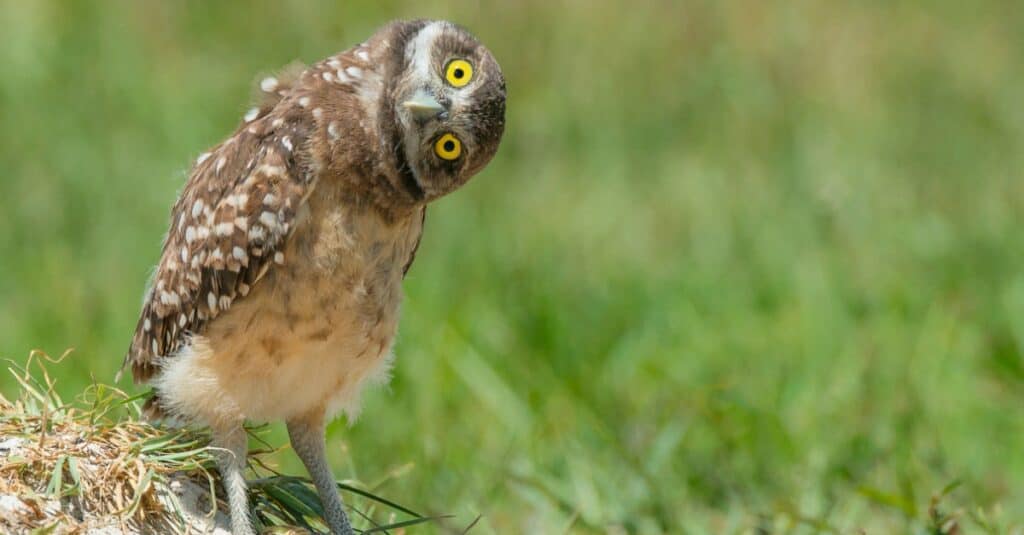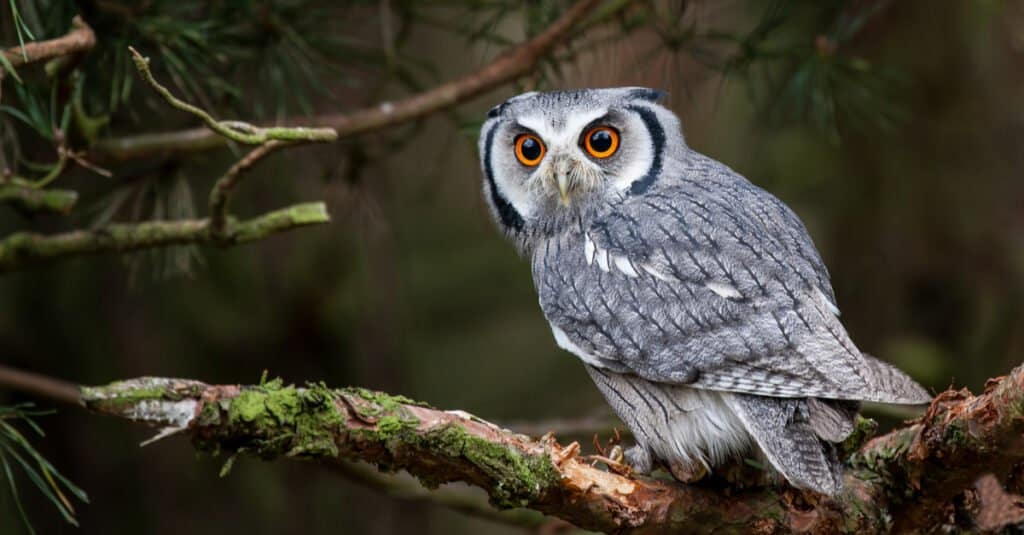Owls are mainly nocturnal birds of prey that hunt small mammals, reptiles, amphibians, and other birds. They swallow their prey whole and regurgitate the feathers, fur, and bones as pellets. There are up to 268 species of modern owl on every continent except Antarctica. However, there could have been more. Here are five extinct owls that we’ll never see again, plus one owl that’s on the endangered list.
1. Cuban Giant Owl (Ornimegalonyx)

A Stamp printed in CUBA shows image of a Giant Owl with the designation “Ornimegalonyx oteroi” from the series “Prehistoric Fauna”, circa 1982
©iStock.com/AlexanderZam
The Cuban giant owl is an extinct genus endemic to the Cuban islands. It was a large bird and probably flightless, although paleontologists debate its flight capabilities. Whether it could fly or not, this was the largest owl that’s ever lived and it’s closely related to modern owl species.
Its remains are found in cave deposits dated in the late Pleistocene era 126-11,000 years ago. It was three feet seven inches tall and weighed up to thirty pounds with very long legs compared to its bulky body and short tail. Experts think it resembled a giant version of today’s burrowing owl.
Because its legs were long and strong it’s thought they were capable runners. A small keel on the breast bone that anchors flight wings to the chest meant it may have been able to achieve short, low flights when needed. Modern chickens and turkeys do the same when threatened.
The Cuban giant owl’s prey was most likely rodents which it crushed with sharp talons. The biggest owl that ever lived became extinct around 10,000-8,000 years ago when many megafauna species died out. Its fate was bound up with climate change as the ice sheet melted and the Ice Age ended. The arrival of early humans who may have hunted this large ground bird is another probable reason.

Extinct giant Cuban owls resembled burrowing owls
©iStock.com/SandyMossPhotography
2. The Laughing Owl (Sceloglaux albifacies)
Endemic to New Zealand the laughing owl was first identified in 1840 but was almost extinct just five years later in 1845. A few survived in the wild until 1914 but by 1930 they were gone.
It was brown and white striped with a stumpy tail. Laughing owls were named after their unusual ‘cak-cak-cak’ call that was believed to sound like a mad man’s laugh. It was a forest dweller, but also built nests in the open countryside taking advantage of limestone cavities and hollow trees. Its diet is known from bones found in old nesting sites. They ate native birds like kiwi and duck but also tuatara a lizard-type reptile.
No one is sure how the laughing owl became extinct, but one theory posed by experts is a virus was spreading through the species and as settlers arrived in New Zealand their habitat was eroded. Settlers introduced rats, cats, and dogs which may have preyed on them too.
If you’d like to see a laughing owl there are preserved specimens in the British Museum, London.

Extinct laughing owls were endemic to New Zealand where they lived in limestone cavities and hollow trees.
©ian woolcock/Shutterstock.com
3. Rodrigues Owl (Otus murivorus)
This extinct owl lived on the Mascarene island of Rodrigues south of Madagascar. There are several names for the Rodrigues owl including Leguat’s owl, Rodrigues lizard owl and Rodrigues scops owl. Little is known about it, but there were three types of Mascarene owls all descended from the large oriental scops owl.
Reports from a French sailor named Tafforet, who was marooned on Mascarene for nine months in the 1700s, describe this extinct owl as very like the brown owl. It lived in trees and called when the weather was fine. During bad weather, they did not call. Partially fossilized bones indicate the Rodrigues owl was around 14 inches long, but the females were several inches longer. It had ear tufts and bare legs.
It’s thought they went extinct in the mid-18th century because no sightings are recorded past 1761. The influx of humans and rats that traveled with them on ships are the likely reasons why they were wiped out.
4. Mauritian Barn Owl (Otus sauzieri)
The extinct Mauritian barn owl was a bird of many names! It was also called Mauritius lizard owl, Mauritius scops owl, Commerson’s owl, Newton’s owl, and Sauzier’s owl.
Despite its many names, this owl was extinct by the mid-1800s. It was discovered from partially fossilized bones and appears to be endemic to the island of Mascarene.
Alongside its bones, a sketch was made by explorer and ex-trooper de Jossigny in 1770 which confused naturalists because it had ear tufts. It was thought the Mauritian barn owl was a barn owl species without them. More recent DNA taken from a leg bone indicates they were part of the scops owl family.
This extinct owl was the largest of the genus measuring up to 23 inches long and probably the largest carnivore on the island. Experts think it ate small mammals and birds. It was still spotted in the southeastern areas in the 1830s, but settlers’ land developments eroded its habitat. It was declared extinct in 1859.

Extinct Mauritian barn owl was part of the scops owl family.
©Alan Tunnicliffe/Shutterstock.com
5. Miosurnia diurnal
Miosurnia diurnal was an unusual owl that lived in the late Miocene era six to 9.5 million years ago. It was unusual because it hunted during the day.
It’s only known from the fossil record, but it’s important because it sheds light on the development of modern owls. Fossilized remains were found in the Linxia Basin of China‘s Gansu province. They are so well preserved it’s possible for paleontologists to see the eye bones (scleral ossicles) and deduce they weren’t large enough to let in enough light for night-hunting.
Miosurnia diurnal was 12 inches long and probably weighed up to 0.7 pounds. Because the fossilized specimen died shortly after eating a meal, it’s possible to see it preyed on small mammals of the time. This article from the PNAS journal tells miosurnia diurnal’s story in more depth if you want to read more.
6. Madagascar Red Owl (Tyto soumagnei) – Endangered
The Madagascar red owl is one of the more recent losses on this extinct owls list, but there’s a twist to its tale. It was first classified in 1878 but thought lost due to habitat destruction and falling prey to settlers’ cats, dogs, and rats. It was found again in 1993!
It’s one of the world’s rarest owls and very similar in appearance to barn owls measuring up to 12 inches and weighing in at 11-15 ounces. It has a pale cream barn owl type face with a pale bill, but gets the name ‘red owl’ from an orangey-red blush on its feathers.
It hunts at night in rainforests, tropical forests, and open landscapes like banana fields. It’s so rare it’s part of a biodiversity conservation program that protects 190,000 hectares of land from logging.
A subspecies of Madagascar red owl called the comoro scops owl is identified in the fossil record, but unfortunately, this large owl is definitely extinct.
That concludes our list of extinct owls. It’s a sad story because many of these species are extinct because their habitats were eroded by human activity. This is an issue that’s still endangering plant and animal species today.
The photo featured at the top of this post is © Mauricio S Ferreira/Shutterstock.com
Thank you for reading! Have some feedback for us? Contact the AZ Animals editorial team.






